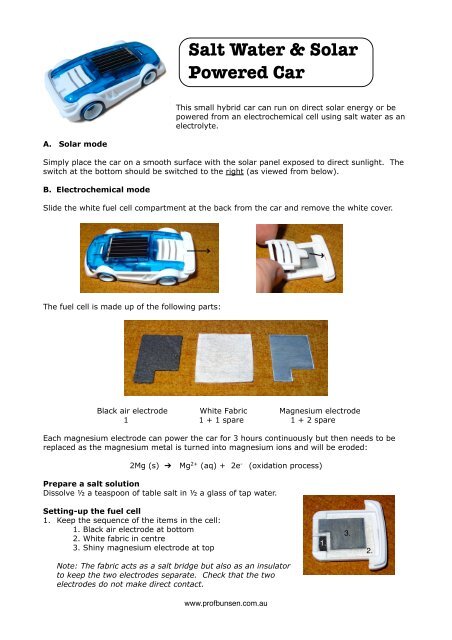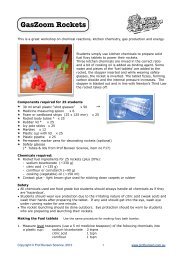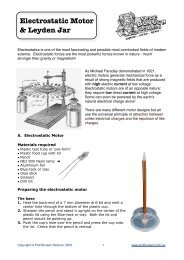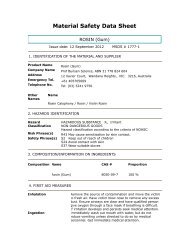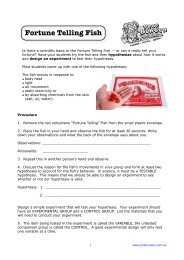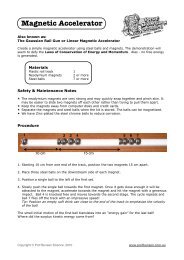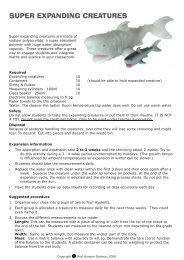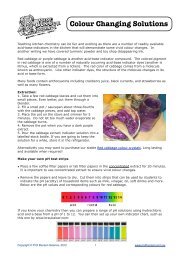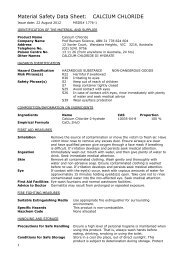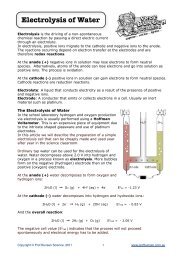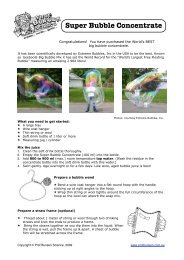Salt Water & Solar Powered Car - Prof Bunsen
Salt Water & Solar Powered Car - Prof Bunsen
Salt Water & Solar Powered Car - Prof Bunsen
Create successful ePaper yourself
Turn your PDF publications into a flip-book with our unique Google optimized e-Paper software.
<strong>Salt</strong> <strong>Water</strong> & <strong>Solar</strong><br />
<strong>Powered</strong> <strong>Car</strong><br />
This small hybrid car can run on direct solar energy or be<br />
powered from an electrochemical cell using salt water as an<br />
electrolyte.<br />
A. <strong>Solar</strong> mode<br />
Simply place the car on a smooth surface with the solar panel exposed to direct sunlight. The<br />
switch at the bottom should be switched to the right (as viewed from below).<br />
B. Electrochemical mode<br />
Slide the white fuel cell compartment at the back from the car and remove the white cover.<br />
The fuel cell is made up of the following parts:<br />
Black air electrode White Fabric Magnesium electrode<br />
1 1 + 1 spare 1 + 2 spare<br />
Each magnesium electrode can power the car for 3 hours continuously but then needs to be<br />
replaced as the magnesium metal is turned into magnesium ions and will be eroded:<br />
2Mg (s) ➔ Mg 2+ (aq) + 2e -<br />
(oxidation process)<br />
Prepare a salt solution<br />
Dissolve ½ a teaspoon of table salt in ½ a glass of tap water.<br />
Setting-up the fuel cell<br />
1. Keep the sequence of the items in the cell:<br />
1. Black air electrode at bottom<br />
2. White fabric in centre<br />
3. Shiny magnesium electrode at top<br />
1.<br />
3.<br />
2.<br />
Note: The fabric acts as a salt bridge but also as an insulator<br />
to keep the two electrodes separate. Check that the two<br />
electrodes do not make direct contact.<br />
www.profbunsen.com.au
2. Remove the magnesium electrode and wet the white fabric with four drops of salt solution<br />
using the pipette.<br />
3. Replace the magnesium electrode and then the white cover.<br />
4. <strong>Car</strong>efully slide the fuel cell back into the car, checking that the two electrode strips<br />
(magnesium and black electrode) slide in below the metal contacts of the car. Do not force<br />
as this may damage the electrodes.<br />
5. Switch the bottom switch to the left (as viewed from below) and run the car on a smooth<br />
surface.<br />
Please Note<br />
• When the car loses power, simply add a few drops of salt water to the exposed fabric at the<br />
back of the car.<br />
• If only stopping the car for short periods of time, you can switch the bottom switch to the<br />
right (solar mode)<br />
BUT<br />
• It is important to clean the fuel cell each time you stop using the car else the<br />
electrochemical cell will keep on producing electricity and shorten the cell’s life.<br />
- Gently rinse the black electrode under tap water. Do not scrub with fingers.<br />
- Wash the magnesium electrode, white fabric and white plastic parts under tap water with<br />
your fingers and dry separately.<br />
Regenerating the electrochemical cell (Optional)<br />
Over time you will find that the magnesium will get a black residue built-up on its surface. You<br />
can scrape this off will a blunt knife or screwdriver (careful!) and then sand the magnesium so<br />
that it is shiny again. Use very fine sand paper. Now refit everything and add the salt water.<br />
www.profbunsen.com.au


